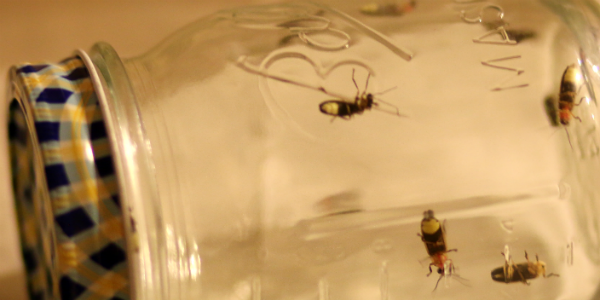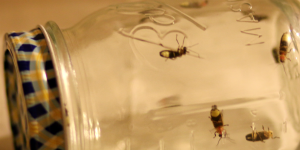Glow-in-the-dark Nighttime Summer Science
A test tube of phytoplankton offers a no-mess way to let kids observe biochemical processes, circadian rhythms, and bioluminescence. Move over fireflies, phytoplankton live longer, which makes them a great option for home science.

On the first night of a fifth grade camping trip earlier this year, our group leader shuffled us all down to the beach in the dark. The kids were on a phytoplankton mission, and the dark beach was the place to be. The students scampered down the hillside, across the street, over the bridge, and into the sand with no problem in the dark. Feeling much less surefooted, I stumbled cautiously along behind them. Once on the beach, they began gently shifting the sand with their hands and watching for flashes of blue, the bioluminescence of phytoplankton.
I felt particularly blind that night. My eyes struggled to adjust to the darkness and distinguish between varying shades of dark. I stared intently at the dark sand, hoping to catch a glimpse of light. Kids all around me were oohing and ahhing, but I never saw any of the glowing flashes of the phytoplankton, momentary pinpoints of color in the sand indicating the microscopic organisms were there.
Glow in the Dark
Bioluminescence can be awe-inspiring, especially if you are lucky enough to land on a beach (or in a field) where there are thousands of luminescing organisms. But this is something students can also enjoy and explore on a smaller scale at home. Fireflies (or lightning bugs) are one common summer example of bioluminescence in insects. Unfortunately, while carefully catching a jar of fireflies at dusk may be fun, fireflies in a jar may not live as long as you expect, even with holes in the lid for air, and may not show off their light in the way you expect either. (My kids collected a jar of fireflies in preparation for this post, and the fireflies died astoundingly quickly and did not glow much when the lights were off.)
Another option for kids to study bioluminescence at home is to use dinoflagellates like Pyrocystis lunula (P. lunula) or Pyrocystis fusiformis. That sounds like a mouthful, but dinoflagellates are really just a type of phytoplankton, microscopic plantlike organisms. While not all dinoflagellates are bioluminescent, some are. A chemical reaction that takes place within the organism emits light energy—which we see as a pulse of colored light. Spending time on a dark beach is one way to observe phytoplankton. But you can also order a container of these single-celled ocean plants and give kids an exciting nighttime science adventure at home!
With a test tube of P. lunula cultures, students can observe the samples at night and watch for patterns of bioluminescence. When do they light up? How long do flashes of light last? How bright are the flashes? What effect does other light in the environment have on the frequency and timing of the bioluminescence? What are circadian cycles, and what do these cycles have to do with dinoflagellates?
Adapting a Project for Home Use
The Bioluminescence: Investigating Glow-in-the-Dark Dinoflagellates project outlines a formal science fair project exploration of dinoflagellates in terms of circadian cycles and whether or not altering patterns of light disrupts or alters those cycles. The questions and procedures in the student biochemistry project can help inform a home activity, but you and your kids can be a lot more casual in your home-based exploration and observation of dinoflagellates.
Watching a jar or test tube of cultures throughout the day and observing patterns over a series of days at certain times will help kids see the natural rhythms (and visible result of the biochemical process) in action and opens up topics for discussion, further reading, and connection. What other organisms demonstrate bioluminescence? Is bioluminescence only time-based or can it be a form of communication? What other organisms have circadian cycles? Do we have these kinds of cycles?
Easy Home Science
An exploration of dinoflagellates can be a lot of fun at home over the summer. The P. lunula don't have to be fed and will live much longer than fireflies! You don't need to set up a tank, and you don't want to dump them in the family fish tank. (Many fish tank owners spend a lot of time trying to get rid of dinoflagellates!) Instead, follow the procedure in the Science Buddies project to create holders for the test tube samples and let the observation begin!
You might not be able to read by the light of these organisms, but they will certainly give you and your kids a lot to talk about in terms of bioluminescence and circadian rhythms. Plus, in the daylight, if you have a microscope at home, you may be able to carefully take a closer look! (While some zooplankton can be seen with a magnifying glass, phytoplankton are microscopic.)
If your kids get really excited about this activity, be sure and take a look together at the Aquarist and Marine Biologist career profiles!
See also: The Wonder of Bioluminescence: Organisms that Glow.
Storybook Connections
To pair up science-themed reading with your summer family science activities, check your local library for books like these:
- Plankton (Glow-In-The-Dark Animals)
- Plankton: Wonders of the Drifting World
- Sea Soup: Phytoplankton
- Spineless
- Fireflies (Nocturnal Animals)
- Fireflies (Bugs, Bugs, Bugs!)
- Fireflies (Penguin Young Readers, L3)
- The Fireflies Book: Fun Facts About the Fireflies You Loved as a Kid
Categories:
You Might Also Enjoy These Related Posts:
- Plastics and Earth Day - Science Projects
- Arduino Science Projects and Physical Computing
- 10+ Robotics Projects with the BlueBot Kit
- 5 STEM Activities with Marshmallow Peeps
- March Madness Basketball Science Projects: Sports Science Experiments
- Women in STEM! More than 60 Scientists and Engineers for Women's History Month
- Explore Artificial Intelligence and Machine Learning with Student AI Projects
- 10 Reasons to Do the Rubber Band Car Engineering Challenge










